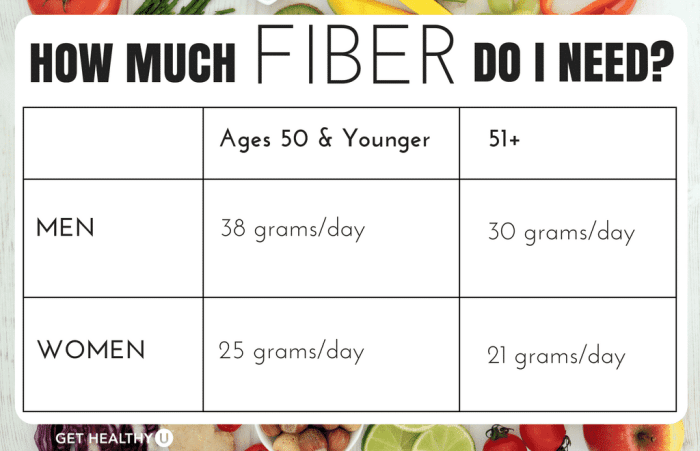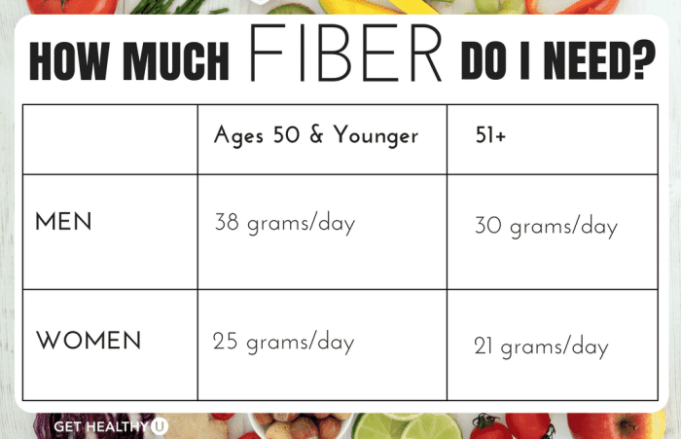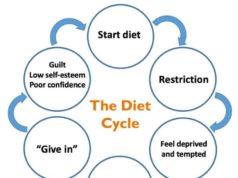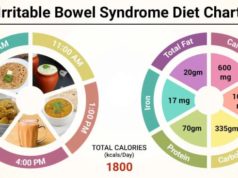How much dietary fiber per day should you aim for? This question often arises when we consider our overall health and well-being. Fiber, a type of carbohydrate our bodies cannot digest, plays a vital role in maintaining digestive health, regulating blood sugar, and managing cholesterol levels. It is a crucial component of a balanced diet, and understanding its importance can lead to a healthier lifestyle.
Dietary fiber comes in two forms: soluble and insoluble. Soluble fiber dissolves in water, forming a gel-like substance that can help lower cholesterol and regulate blood sugar levels. Insoluble fiber, on the other hand, remains intact and adds bulk to stools, promoting regular bowel movements. Both types of fiber are essential for maintaining optimal digestive health.
Dietary Fiber
Dietary fiber is a type of carbohydrate that the human body cannot digest. It is found naturally in plant-based foods, such as fruits, vegetables, legumes, and whole grains. Fiber plays a crucial role in maintaining overall health and well-being.
Types of Dietary Fiber
Dietary fiber is broadly categorized into two main types: soluble and insoluble fiber. Each type has unique properties and functions within the body.
- Soluble fiber dissolves in water and forms a gel-like substance in the digestive tract. It helps regulate blood sugar levels, lower cholesterol, and promote satiety.
- Insoluble fiber does not dissolve in water and adds bulk to the stool. It helps prevent constipation, promotes regular bowel movements, and aids in the elimination of waste products.
Benefits of Dietary Fiber
Consuming adequate dietary fiber offers a wide range of health benefits, impacting various aspects of the body’s functioning.
- Improved Digestive Health: Fiber acts as a prebiotic, promoting the growth of beneficial bacteria in the gut, which aids in digestion and nutrient absorption. It also adds bulk to stool, preventing constipation and promoting regular bowel movements.
- Blood Sugar Regulation: Soluble fiber slows down the absorption of sugar from the digestive tract, preventing rapid spikes in blood sugar levels. This is particularly beneficial for individuals with diabetes or those at risk of developing the condition.
- Cholesterol Management: Soluble fiber binds to cholesterol in the digestive tract, preventing its absorption into the bloodstream. This helps lower LDL (bad) cholesterol levels, reducing the risk of heart disease.
- Weight Control: Fiber promotes satiety, making you feel fuller for longer, which can help control appetite and reduce calorie intake. It also slows down the digestion process, leading to a more gradual release of energy, preventing energy crashes and promoting weight management.
Foods Rich in Dietary Fiber
A diverse range of foods naturally contains dietary fiber. It’s important to include a variety of these foods in your diet to ensure you’re getting a balanced intake of both soluble and insoluble fiber.
Soluble Fiber
- Fruits: Apples, bananas, berries, oranges, pears
- Legumes: Beans, lentils, peas
- Oats: Oatmeal, oat bran
- Other: Psyllium husk, flaxseed
Insoluble Fiber
- Vegetables: Broccoli, carrots, celery, green beans, spinach
- Whole Grains: Brown rice, quinoa, whole wheat bread, whole grain pasta
- Nuts and Seeds: Almonds, chia seeds, flaxseeds, sunflower seeds
Recommended Daily Intake
The recommended daily intake of dietary fiber varies depending on age, gender, and individual health needs. Generally, adults should aim for 25-38 grams of fiber per day. However, specific recommendations can differ based on various factors.
Factors Influencing Fiber Needs
Individual fiber needs can be influenced by several factors, including:
- Activity Level: More active individuals generally require more fiber as it helps regulate bowel movements and provides energy.
- Health Conditions: Certain health conditions, such as diabetes, heart disease, and irritable bowel syndrome, may necessitate adjustments in fiber intake.
- Medication Use: Some medications, particularly those for digestive issues, can interact with fiber intake. It’s crucial to consult a healthcare professional for personalized advice.
Recommended Fiber Intake for Different Groups
Here’s a table summarizing the recommended daily fiber intake for various demographic groups:
| Age Group | Men | Women | Children | Seniors |
|---|---|---|---|---|
| 1-3 years | 19 grams | 19 grams | 14-19 grams | – |
| 4-8 years | 25 grams | 25 grams | 25 grams | – |
| 9-13 years | 31 grams | 26 grams | 31 grams | – |
| 14-18 years | 38 grams | 26 grams | 38 grams | – |
| 19-50 years | 38 grams | 25 grams | – | 25-30 grams |
| 51+ years | 30 grams | 21 grams | – | 25-30 grams |
It’s important to note that these are general recommendations, and individual needs may vary. Consulting a healthcare professional is crucial for personalized advice.
Fiber Deficiency and Excess
While fiber is essential for overall health, it’s crucial to understand the potential consequences of both inadequate and excessive intake. A balanced approach is key to reaping the benefits of fiber without experiencing adverse effects.
Fiber Deficiency
Fiber deficiency, also known as insufficient fiber intake, can lead to various health issues.
- Constipation: Fiber adds bulk to stool, promoting regular bowel movements. Insufficient fiber intake can slow down digestion, leading to constipation, characterized by infrequent bowel movements, hard stools, and difficulty passing stool.
- Diverticular Disease: Diverticular disease occurs when small pouches (diverticula) form in the lining of the colon. While the exact cause is unknown, a low-fiber diet is a contributing factor. Insufficient fiber intake can lead to increased pressure in the colon, potentially causing diverticula to form.
- Heart Disease: Fiber, particularly soluble fiber, can help lower cholesterol levels, which is a significant risk factor for heart disease. Insufficient fiber intake can contribute to higher cholesterol levels, increasing the risk of heart disease.
Signs and Symptoms of Fiber Deficiency
Recognizing the signs and symptoms of fiber deficiency is essential for addressing the issue promptly. Some common symptoms include:
- Constipation: As mentioned earlier, infrequent bowel movements, hard stools, and difficulty passing stool are primary indicators of constipation, a common symptom of fiber deficiency.
- Bloating and Gas: While excessive fiber can cause bloating and gas, a lack of fiber can also lead to these symptoms. Fiber helps regulate digestion, and insufficient fiber can disrupt this process, resulting in bloating and gas.
- Headaches: Although not directly related to fiber deficiency, some individuals experience headaches due to constipation, which can be a symptom of inadequate fiber intake.
- Fatigue: Fiber deficiency can indirectly affect energy levels. A lack of fiber can lead to poor digestion and nutrient absorption, potentially causing fatigue.
Excessive Fiber Consumption
While fiber is beneficial, excessive intake can also have negative consequences.
- Bloating and Gas: Excessive fiber intake can cause bloating and gas due to the increased fermentation of fiber in the gut by bacteria. This process produces gas, leading to bloating and discomfort.
- Diarrhea: Too much fiber can overwhelm the digestive system, leading to diarrhea. The body struggles to absorb excess fiber, resulting in loose stools and frequent bowel movements.
- Nutrient Deficiencies: Excessive fiber can interfere with the absorption of certain nutrients, such as iron, zinc, and calcium. This is because fiber binds to these minerals in the gut, hindering their absorption.
Incorporating Fiber into Your Diet

Increasing your fiber intake can be a significant step toward improving your overall health. However, it’s essential to do it gradually to avoid digestive discomfort. This section provides practical tips and resources to help you incorporate fiber into your diet effectively.
Sample Meal Plan
A well-balanced meal plan should include a variety of fiber-rich foods throughout the day. Here’s an example of a sample meal plan:
- Breakfast: Oatmeal with berries and nuts, a whole-wheat English muffin with avocado, or a smoothie with spinach, banana, and chia seeds.
- Lunch: A salad with grilled chicken or fish, quinoa, and plenty of leafy greens. Alternatively, a whole-wheat sandwich with lean protein and plenty of vegetables.
- Dinner: Baked salmon with roasted vegetables, lentil soup with whole-wheat bread, or a vegetarian chili with black beans and corn.
- Snacks: Fruits like apples, pears, or bananas, a handful of almonds or walnuts, or a cup of yogurt with granola.
Tips for Gradual Increase
Increasing your fiber intake too quickly can lead to bloating, gas, and other digestive issues. It’s best to gradually increase your intake over time. Here are some tips:
- Start slowly: Begin by adding a few extra grams of fiber to your diet each day. For example, you can add a tablespoon of chia seeds to your yogurt or a few slices of bell pepper to your sandwich.
- Choose high-fiber foods: Focus on whole grains, fruits, vegetables, legumes, and nuts. These foods provide a good source of both soluble and insoluble fiber.
- Drink plenty of water: Fiber absorbs water in your digestive tract, so it’s important to stay hydrated. Aim for eight glasses of water per day.
- Listen to your body: If you experience any digestive discomfort, reduce your fiber intake for a few days and then gradually increase it again.
High-Fiber Recipes
Here are some delicious and healthy recipes that feature high-fiber ingredients:
- Black Bean Burgers: These flavorful burgers are packed with protein and fiber. You can find many variations of this recipe online, and they are easy to customize to your taste.
- Lentil Soup: This hearty soup is a great source of protein, fiber, and iron. It’s also a budget-friendly meal option.
- Quinoa Salad with Roasted Vegetables: This colorful salad is a refreshing and satisfying meal. It’s a great way to get your daily dose of fiber and antioxidants.
- Oatmeal with Berries and Nuts: This classic breakfast is a simple and nutritious way to start your day. You can add a variety of toppings to customize it to your liking.
Fiber and Weight Management
Fiber plays a crucial role in weight management by influencing satiety, calorie intake, and blood sugar levels. It is a type of carbohydrate that the human body cannot digest. This indigestible nature contributes to its unique benefits for weight control.
The Role of Fiber in Weight Management
Fiber contributes to weight management through various mechanisms:
- Promotes Satiety: Fiber absorbs water in the digestive tract, expanding its volume and creating a feeling of fullness. This helps you feel satisfied after eating, reducing the urge to overeat.
- Reduces Calorie Intake: Because fiber adds bulk to food without providing calories, it can help you feel full on fewer calories. This is especially helpful when trying to lose weight or maintain a healthy weight.
- Regulates Blood Sugar Levels: Fiber slows down the absorption of sugar into the bloodstream, preventing blood sugar spikes and crashes. This helps prevent cravings and overeating, contributing to stable energy levels and better appetite control.
Effects of Soluble and Insoluble Fiber on Weight Loss
- Soluble Fiber: This type of fiber dissolves in water, forming a gel-like substance in the digestive tract. It slows down digestion, promotes satiety, and helps regulate blood sugar levels. Examples of soluble fiber include pectin, found in fruits and vegetables, and beta-glucan, found in oats and barley.
- Insoluble Fiber: This type of fiber does not dissolve in water and adds bulk to stool, promoting regular bowel movements. While it does not directly affect blood sugar levels or satiety as much as soluble fiber, it plays a crucial role in overall digestive health. Examples of insoluble fiber include cellulose, found in whole grains, and lignin, found in fruits and vegetables.
Tips for Using Fiber-Rich Foods to Support Healthy Weight Management, How much dietary fiber per day
- Start Slowly: Increasing fiber intake too quickly can cause bloating, gas, and discomfort. Gradually increase your fiber intake by adding one to two servings of high-fiber foods per day.
- Choose Whole Grains: Swap refined grains like white bread and white rice for whole grains like brown rice, quinoa, and whole-wheat bread.
- Incorporate Fruits and Vegetables: Aim for at least five servings of fruits and vegetables per day. Include a variety of colors to ensure a diverse range of fiber types.
- Drink Plenty of Water: Fiber absorbs water, so it’s essential to stay hydrated. Drinking enough water helps prevent constipation and promotes the smooth passage of fiber through the digestive system.
- Choose Legumes: Lentils, beans, and chickpeas are excellent sources of fiber and protein, making them ideal for weight management.
- Read Food Labels: Pay attention to the fiber content of packaged foods. Choose options that are higher in fiber.
Fiber and Digestive Health
Fiber plays a crucial role in maintaining a healthy digestive system. It acts as a natural regulator, promoting regular bowel movements and preventing constipation. Additionally, fiber supports a healthy gut microbiome, which is essential for overall well-being.
Fiber and Regular Bowel Movements
Fiber’s ability to absorb water and create bulk in the stool is key to its role in promoting regular bowel movements. As fiber travels through the digestive tract, it adds volume to the stool, making it easier to pass. This process helps prevent constipation, a common digestive issue characterized by infrequent bowel movements and difficulty passing stools.
Fiber and the Gut Microbiome
The gut microbiome is a complex ecosystem of trillions of bacteria that reside in the digestive tract. These bacteria play a vital role in digestion, nutrient absorption, and immune function. Fiber acts as a prebiotic, providing nourishment for these beneficial bacteria.
A diverse and healthy gut microbiome is linked to numerous health benefits, including:
- Improved digestion and nutrient absorption
- Enhanced immune function
- Reduced risk of chronic diseases such as heart disease, type 2 diabetes, and certain cancers
Fiber intake helps maintain this balance by providing fuel for the beneficial bacteria, promoting their growth and activity.
Managing Digestive Discomfort
While fiber is essential for digestive health, increasing fiber intake too quickly can lead to digestive discomfort, such as bloating, gas, and abdominal cramps. To manage these symptoms, it’s important to increase fiber intake gradually.
Here are some tips:
- Start by adding a few extra grams of fiber to your diet each day and gradually increase the amount over time.
- Choose high-fiber foods that are easily digestible, such as cooked vegetables, fruits, and whole grains.
- Drink plenty of water to help fiber move through the digestive tract smoothly.
- If you experience significant discomfort, consult a healthcare professional to rule out any underlying medical conditions.
Fiber and Chronic Diseases
Fiber plays a crucial role in preventing and managing chronic diseases, which are long-term health conditions that develop gradually over time. A diet rich in fiber has been linked to a reduced risk of heart disease, type 2 diabetes, and certain types of cancer.
Mechanisms of Fiber in Disease Prevention
Fiber contributes to disease prevention through various mechanisms. Here are some key ways:
* Lowering Cholesterol Levels: Soluble fiber, found in oats, beans, and apples, can bind to cholesterol in the digestive tract, preventing its absorption into the bloodstream. This helps lower LDL (bad) cholesterol levels, reducing the risk of heart disease.
* Improving Blood Sugar Control: Fiber slows down the absorption of sugar into the bloodstream, helping to regulate blood sugar levels. This is particularly important for individuals with type 2 diabetes, as it can help prevent blood sugar spikes and improve insulin sensitivity.
* Promoting Healthy Gut Bacteria: Fiber acts as a prebiotic, feeding the beneficial bacteria in the gut. These bacteria produce short-chain fatty acids, which have anti-inflammatory properties and contribute to overall gut health.
Fiber and Heart Disease
Numerous studies have shown a strong association between dietary fiber intake and a reduced risk of heart disease.
* The Framingham Heart Study: A long-term study that followed thousands of participants over decades found that those who consumed more fiber had a lower risk of developing coronary heart disease.
* The Women’s Health Initiative: This large-scale study demonstrated that women who consumed more fiber had a lower risk of stroke.
Fiber and Type 2 Diabetes
High-fiber diets have been consistently linked to a reduced risk of developing type 2 diabetes.
* The Nurses’ Health Study: This study followed over 120,000 nurses for over 20 years and found that those who consumed more fiber had a lower risk of developing type 2 diabetes.
* The Diabetes Prevention Program: This clinical trial showed that a lifestyle intervention program that included dietary changes, such as increasing fiber intake, significantly reduced the risk of developing type 2 diabetes.
Fiber and Cancer
Fiber intake has been associated with a lower risk of certain types of cancer, including colorectal cancer.
* The World Cancer Research Fund: This organization has concluded that a diet high in fiber is associated with a reduced risk of colorectal cancer.
* The European Prospective Investigation into Cancer and Nutrition (EPIC): This large-scale study involving over 500,000 participants found that those who consumed more fiber had a lower risk of developing colorectal cancer.
Conclusion
Incorporating adequate fiber into your diet can significantly improve your overall health and well-being. By understanding the recommended daily intake, recognizing potential deficiencies and excesses, and making informed choices about fiber-rich foods, you can reap the numerous benefits of this essential nutrient. Remember to consult with a healthcare professional for personalized guidance and to address any specific concerns you may have.
FAQs: How Much Dietary Fiber Per Day
What are some good sources of soluble fiber?
Good sources of soluble fiber include oats, beans, lentils, apples, and pears.
What are some good sources of insoluble fiber?
Good sources of insoluble fiber include whole grains, wheat bran, vegetables like broccoli and carrots, and nuts and seeds.
Can I get too much fiber?
While fiber is generally beneficial, consuming too much too quickly can lead to digestive discomfort such as bloating, gas, and diarrhea. It is essential to increase fiber intake gradually to allow your body to adjust.
How can I incorporate more fiber into my diet?
Start by adding a few servings of fiber-rich foods to your daily meals. Choose whole grains over refined grains, include plenty of fruits and vegetables, and incorporate beans, lentils, and nuts and seeds into your diet.
Aiming for 25-35 grams of dietary fiber per day is a good target, but it’s not always easy to hit that goal. You might wonder if diet soda can help, and whether it’s keto-friendly – you can find out more about can you drink diet soda on keto – but remember, fiber comes from fruits, vegetables, and whole grains, not artificial sweeteners.
So focus on incorporating those foods into your diet for a healthy dose of fiber.
Aiming for 25-35 grams of dietary fiber daily is a great goal for overall health. But while fiber is essential, it’s not a magic bullet for weight loss. You might be wondering if is running the best way to lose weight , and the answer is that it’s one effective tool, but it needs to be combined with a balanced diet and other healthy habits.
Just like fiber, running alone won’t guarantee weight loss, but it can be a valuable part of a comprehensive approach.
Aiming for 25-35 grams of dietary fiber per day is a great goal, but don’t forget about other essential nutrients like iodine! You can learn more about how to get iodine in your diet here , and once you’ve got that covered, you can focus on hitting your daily fiber target.
























